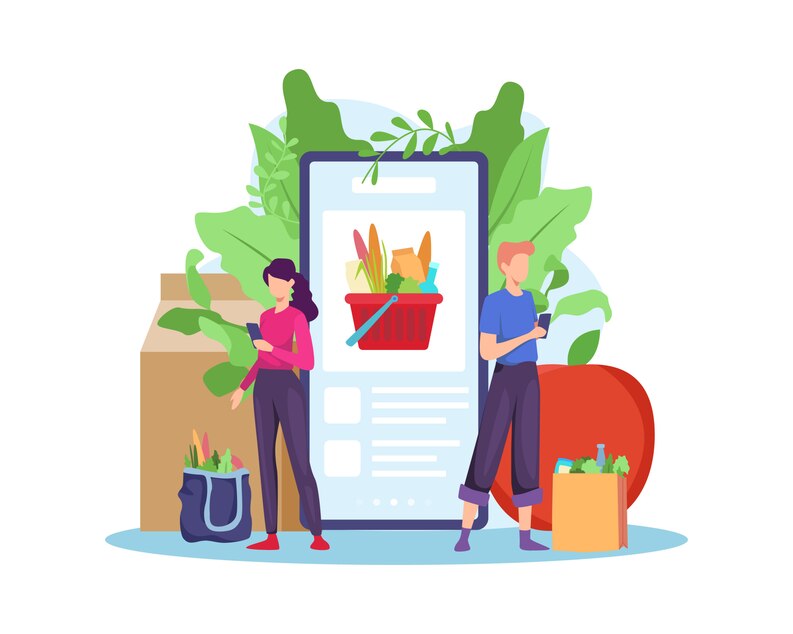Organic Food Business App – Complete Guide

Introduction
Acquiring an organic food business app is an interesting venture in today’s health-conscious environment. With the growing demand for organic and natural products, there is a substantial market waiting to be explored. In this thorough tutorial, we will help you through the processes of creating a successful organic food business app, from concept creation to marketing and beyond.
1. Concept Development
It is critical to have a clear and well-defined concept before jumping into app development. Here are some important factors to consider as you develop your organic food company app idea:
– Target Audience: Determine your target audience. Are you targeting health-conscious people, eco-conscious people, or a specialized niche like organic baby food?
– Unique Selling Proposition (USP): What distinguishes your app from the competition? This might be the quality of your organic goods, your innovative sourcing techniques, or a particular function in your app.
– Product Range: Choose the organic items you’ll sell through your app. Organic fruits and vegetables, dairy, meat, packaged goods, and even specialized items like gluten-free or vegan products may fall into this category.
– Sourcing: Make a plan for your sourcing approach. Will you collaborate with local farmers, form alliances with organic suppliers, or establish your own organic farm?
– Certifications: Understand the certification standards for organic products. You may be required to follow various standards and certifications depending on your area.
– Pricing Strategy: Determine your pricing strategy. Will you provide quality organic items or more cheap alternatives?
2. App Development
It’s time to create a food app for your organic food businesses now that you’ve confirmed your concept. The following are the essential steps in this phase:
– Select a Development Platform: Choose whether you want to create a native app (for iOS and Android) or a cross-platform app utilizing technologies such as React Native or Flutter. The latter can help to save development time and expenses.
– Design and User Experience (UX): Make a user-friendly design that is consistent with your brand. Make sure your software is simple to use and visually attractive. If required, hire a designer.
– App Features: Choose the features you want in your app. Product listings, a shopping cart, a secure payment method, customer feedback, and order monitoring are all standard components of an organic food company app.
– Product Listings and Descriptions: Your app’s product listings should be thorough, with high-quality photos and informative descriptions. Include information on the organic certifications, source, and advantages of the product.
– Shopping Cart and Checkout: Implement a user-friendly shopping cart and a safe checkout experience. Allow users to add and remove things, enter promotional coupons, and choose their preferred payment methods.
– User Profiles: Allow users to build profiles that include their personal information, shipping addresses, and order history. This functionality improves the user experience and encourages customers to place repeat orders.
– Push Notifications: Use push notifications to keep consumers up to date on special deals, order changes, and new product arrivals.
– Search and Filter Functionality: Include search and filter options based on categories, brands, and dietary preferences to make it easier for customers to identify specific goods.
– Secure Payment Gateway: To execute transactions, use a dependable and secure payment gateway. Make certain that consumer payment information is secure.
– Order Tracking: Users should be able to follow their orders in real time. This feature increases transparency and consumer trust.
– Customer Support: Allow users to contact customer service or submit comments within the app.
– Backend Development: Create a solid backend system for managing product inventories, user data, orders, and payment processing.
– Testing: Test your app thoroughly for functionality, usability, and security. Identify and resolve any bugs or problems.
– Launch: When your app is finished, publish it to the App Store and Google Play. Make it available via numerous marketing channels.
3. Organic Product Sourcing
A trustworthy supplier of high-quality organic items is required to run a successful organic food business app. Consider the following steps:
– Farmers and Suppliers: Form alliances with local farmers and organic goods providers. Check that they fulfill the certification requirements.
– Quality Control: Maintain the integrity of your products by implementing quality control techniques. Inspect and test your items for organic conformity on a regular basis.
– Storage and Transportation: Set up suitable storage and transportation facilities to ensure that organic products stay fresh and of high quality throughout the delivery process.
– Inventory Management: Implement an effective inventory management system to keep track of the availability and expiry dates of your items.
– Packaging: Choose eco-friendly packaging that complements your brand’s organic and sustainable approach.
4. Delivery and Logistics
Delivery and logistics efficiency are critical to the success of your organic food company app. Take a look at the following:
– Delivery Options: Provide a variety of delivery alternatives, such as normal, expedited, and same-day delivery. Allow consumers to select the option that is most convenient for them.
– Delivery Area: Determine the places in which you will be able to supply delivery services. You may wish to start with a certain region and progressively expand.
– Fleet or Partnership: Choose whether to build your own delivery fleet or collaborate with established delivery services such as Postmates or UberEats.
– Sustainability: Put a premium on sustainability in your delivery techniques. For environmentally conscientious consumers, consider utilizing electric cars or bicycle couriers.
– Tracking and Notifications: Set up a tracking system so that users can keep track of their delivery. Send delivery status alerts and updates.
– Returns and Refunds: Create a clear return and refund policy. Make it easy for clients to commence these steps if necessary.
5. Marketing and Promotion
A robust marketing plan is required to establish momentum and create a consumer base. Here are some great methods for marketing your organic food company app:
– Social Media: Make and keep active social media profiles. Share interesting information, make product posts, and communicate with your audience.
– Content Marketing: Create blog entries, articles, and educational information regarding organic goods, healthy eating, and environmental sustainability. This will assist you in establishing authority in your profession.
– Email Marketing: Create an email list and send out frequent newsletters with news, specials, and instructive information.
– Influencer Marketing: Promote your app by collaborating with organic food and lifestyle influencers.
– Partnerships: Cross-promote your app by partnering with nearby companies, gyms, or wellness facilities.
– Discounts and Promotions: To attract and maintain customers, provide unique discounts and promotions.
– App Store Optimization (ASO): To enhance exposure, optimize your app store listings with relevant keywords, high-quality pictures, and interesting descriptions.
– Customer Reviews: Encourage happy consumers to post good app store reviews. Address any unfavorable feedback as soon as possible and professionally.
6. Customer Support and Feedback
Maintaining client trust and happiness requires excellent customer service. Allow consumers to contact you via several methods, such as email, chat, or phone. Respond to feedback and iteratively enhance your app and services in response to user ideas.
7. Scaling and Expansion
Consider increasing and expanding your offerings as your organic food company app grows in popularity.
You can look into the following options:
– Geographic Expansion: Increase the size of your delivery region to reach additional clients.
– Product Diversification: Add additional organic items or categories to fulfill the requirements and interests of your customers.
– Franchising: Consider franchising your company concept to expand into additional areas, if suitable.
8. Compliance and Regulations
Check that your app and company operations adhere to local and national rules for food safety, organic certification, and data security. Keep up with new legislation and adjust your operations accordingly.
9. Sustainability
Incorporate sustainability into all elements of your organization, from organic product procurement to eco-friendly packaging and delivery techniques. In your marketing efforts, emphasize your dedication to environmentally friendly activities.
10. Data Security and Privacy
Safeguard consumer data and respect their privacy. To protect sensitive information, follow data protection standards and utilize secure payment methods.
11. Feedback and Improvement
Collect client feedback and utilize it to make continual changes to your app and services. To stay competitive, update your software on a regular basis with new features and updates.
12. Customer Loyalty Programs
Implement customer loyalty programs to reward repeat consumers and promote long-term app engagement.
13. Analytics and Insights
Analytic tools may be used to obtain information about consumer behavior, sales patterns, and app performance. This data can assist you in making data-driven business decisions.
14. Legal and Financial Considerations
Consult with legal and financial specialists to establish your business structure, register your app, and successfully manage your cash.
15. Competitive Analysis
Keep up to date on your competition and market trends. Adapt to evolving customer tastes and technology.
16. Continuous Innovation
Continue to innovate and remain ahead of the competition. Consider using upcoming technologies such as augmented reality (AR) for a one-of-a-kind purchasing experience.
Conclusion
Developing a profitable organic food company app is a gratifying undertaking. You may establish an idea, design a user-friendly app using a delivery app builder, acquire high-quality organic items, cultivate a devoted client base, and expand your business by following these steps. To remain competitive in the ever-changing organic food industry, promote sustainability, consumer happiness, and innovation. Your organic food business app may grow and have a great influence on the health and well-being of your clients with devotion and a strong commitment to your mission.






